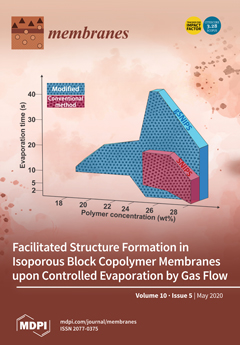The field of membranes saw huge developments in the last decades with the introduction of both polyelectrolyte multilayer (PEM)-based membranes and biomimetic membranes. In this work, we combine these two promising systems and demonstrate that proteopolymersomes (PP+) with the incorporated aquaporin protein can
[...] Read more.
The field of membranes saw huge developments in the last decades with the introduction of both polyelectrolyte multilayer (PEM)-based membranes and biomimetic membranes. In this work, we combine these two promising systems and demonstrate that proteopolymersomes (PP+) with the incorporated aquaporin protein can be distributed in a controlled fashion using PEMs, even on the inner surface of a hollow fiber membrane. In this way, various proteopolymersome multilayers (PPMs) are fabricated using PP+ as the positively charged species in combination with the polyanions poly(styrene 4-sulfonate) (PSS) and poly(acrylic acid) (PAA). It is shown by reflectometry through alternately adsorbing the polyanions and PP+ that, for both PAA and PSS, a good layer growth is possible. However, when the multilayers are imaged by SEM, the PAA-based PPMs show dewetting, whereas vesicular structures can only be clearly observed in and on the PSS-based PPMs. In addition, membrane permeability decreases upon coating the PPMs to 2.6 L∙m
−2∙h
−1∙bar
−1 for PAA/PP+ and 7.7 L∙m
−2∙h
−1∙bar
−1 for PSS/PP+. Salt retentions show that PAA/PP+ layers are defective (salt retentions <10% and high molecular weight cut-off (MWCO)), in line with the observed dewetting behavior, while PPMs based on PSS show 80% MgSO
4 retention in combination with a low MWCO. The PSS/PP+ membranes show a Donnan-exclusion behavior with moderate MgCl
2 retention (50%–55%) and high Na
2SO
4 retention (85%–90%) indicating a high amount of negative charge present within the PPMs. The corresponding PEMs, on the other hand, are predominately positively charged with MgCl
2 retention of 97%–98% and Na
2SO
4 retention of 57%–80%. This means that the charge inside the multilayer and, thus, its separation behavior can be changed when PP+ is used instead of a polycation. When comparing the PPM membranes to the literature, similar performances are observed with other biomimetic membranes that are not based on interfacial polymerization, but these are the only ones prepared using a desired hollow fiber geometry. Combining PEMs and biomimetic approaches can, thus, lead to relevant membranes, especially adding to the versatility of both systems.
Full article






